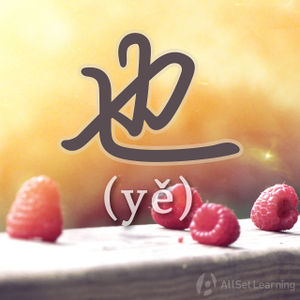Difference between revisions of "Using "ye" and "dou" together"
| Line 57: | Line 57: | ||
=== Books === | === Books === | ||
| − | + | ||
| − | + | {{Source|Integrated Chinese: Level 1, Part 1 (3rd ed)|31-2}} | |
| − | + | {{Source|New Practical Chinese Reader 1 (新实用汉语课本1)|88}} | |
| − | + | {{Source|40 Lessons for Basic Chinese Course (基础汉语40课上册)|73}} | |
| − | + | {{Source|Integrated Chinese: Level 1, Part 1 (3rd ed)|53-4}} | |
| − | + | {{Source|New Practical Chinese Reader 1 (新实用汉语课本1)|88}} | |
| + | {{Source|Basic Patterns of Chinese Grammar|35}} | ||
Revision as of 09:13, 12 December 2017
-
Level
-
Similar to
-
Used for
-
Keywords
If you are trying to draw similarities amongst a group, you will want to pair two key words together. You will want to use 也 (yě) first followed by 都 (dōu) to express that a group of people have something in common.
Contents
Positive Form
Structure
If you're using 也 (yě) and 都 (dōu) in the same sentence, remember to put 也 (yě) first:
Subj. + 也都 + Predicate
The predicate part of the pattern can be a verb or an adjective.
Examples
- 我 很 好 ,我 的 家人 也 都 很 好 。I'm good. So are my family.
- 大人 很 喜欢 这个 餐厅 ,孩子们 也 都 很 喜欢 。Both adults and children like this restaurant.
- 我 老板 是 美国 人 ,很多 客户 也 都 是 美国 人 。My boss is American. Lots of our clients are also Americans.
- 他 很 高 ,他 的 两 个 弟弟 也 都 比较 高 。He's tall. So are his two younger brothers.
- 老板 加班 ,你们 也 都 要 加班 吗 ?The boss works late, but do you all need to work late?
Negative Form
Structure
If you're using 不(bù) or 没(méi) with 也都 ( (yě dōu) in the same sentence, remember to put 不(bù) or 没(méi) after 也都 (yě dōu):
Subj. + 也都 + 不 / 没 + Predicate
Examples
- 我们 也 都 没 吃饭 ,一起 去 吧 。We all haven't eaten. Let's go together.
- 这些 不 贵 ,那些 也 都 不 贵 。These are not expensive. Those aren't expensive, either.
- 我 不 喜欢 Trump ,我 的 朋友 也 都 不 喜欢 他 。I don't like Trump. My friends don't like him, either.
- 你 觉得 你 不 容易 ?我们 也 都 不 容易 。You're saying it isn't easy for you? It isn't for us, either.
- 我 没 去 过 美国 ,我 的 家人 也 都 没 去 过 。I've never been to America. My family have never been there, either.
See also
Sources and further reading
Books
- Integrated Chinese: Level 1, Part 1 (3rd ed) (pp. 31-2) Anything Goes (无所不谈) →buy
- New Practical Chinese Reader 1 (新实用汉语课本1) (pp. 88) Anything Goes (无所不谈) →buy
- 40 Lessons for Basic Chinese Course (基础汉语40课上册) (pp. 73) [ →buy]
- Integrated Chinese: Level 1, Part 1 (3rd ed) (pp. 53-4) Anything Goes (无所不谈) →buy
- New Practical Chinese Reader 1 (新实用汉语课本1) (pp. 88) Anything Goes (无所不谈) →buy
- Basic Patterns of Chinese Grammar (pp. 35) Anything Goes (无所不谈) →buy



